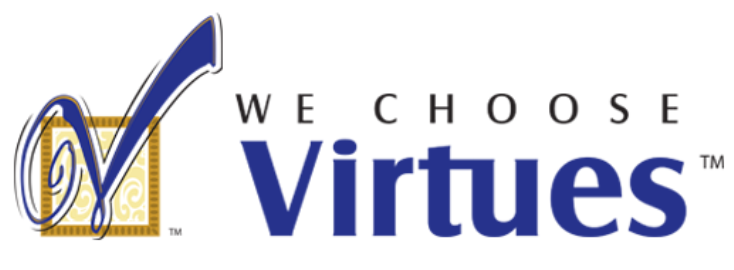Our Unique System
We Choose Virtues uses 4 elements that are unique to our system
___________________________________________________________________
Our Parenting Cards, Teacher's Virtue Cards and Flash Cards, Virtue Clues and Posters contain these 4 consistent elements: The Virtue, the Catchphrase, the Antonyms, and the Kids of VirtueVille.
The front of a Parenting Card (this example is faith-based for Christian homeschooling, NIrV)
The front a Teacher's Virtue Card (this example is secular)
The front a Teacher's Virtue Card (this example is secular)


The Virtue
- Each Virtue is preceded by the words “I am”. “I am Content” for example. Not “I hope so” or “I wish I was.” But “I am”. This phrase creates positive momentum and a sense of personal responsibility and ownership. It is a faith declaration. What we say about ourselves is who we become. People know us by our character, not just by the color of our hair or what sport we play. It is never too early to start building a good reputation.
The Catchphrase
- The “active ingredient” in We Choose Virtues is the Catchphrases. Each one begins with a unique action verb. “I am Content. I have…” for example. This takes the definition of the Virtue and makes it actually do-able. The catchphrases are also clear, accurate definitions that are positive and practical. “I am Content. I have my Wanter under control”. They will become part of your language and you will find yourselves using them to communicate expectations with each other. They suddenly make life much simpler!
The Antonyms
- The Antonyms explain the negative form of the Virtue by using the phrase “I am NOT and “I don’t”. “I am not bored, greedy or always wanting more and I don’t beg or whine!” for example. This helps us recognize attitudes and actions that are unproductive, hurtful or wrong so we can change them. The antonyms are simply a picture of the person we no longer have to be!
The Kids of VirtueVille
- The Virtue Kids are great little role models from various ethnicities. We hope your kids can find someone special that they can relate to. The object each one holds rhymes with their name. “Cake” rhymes with “Jake” for example. The object also begins with the same letter as the Virtue. So, “Cake” and “Content” both start with “C”. This helps non-readers quickly identify and memorize the Virtue.
The back of a Parenting Card and The back of a
Teacher's Virtue Card


The Back of the cards are where this amazing system all comes together.
Virtue User Challenge
- Everyone is given a goal to use the Virtue the whole day. This gives the you a simple and practical activity for everyone to practice. It stimulates focus on the Virtue and promotes character growth individually and as a class or family.
What to say after "I'm sorry"
- A properly constructed apology will go a long way in helping your kids to accept personal responsibility for their character decisions. The goal here is not perfection, but incremental growth.
Kids of VirtueVille story
- This is a short story about the Virtue Kid on the front of the card. It is only one example of how your kids can put Virtue into action in their everyday lives. Ask them to write their own story!
Fun Demonstrations/Teachable Moments
- These simple activities STRETCH your kids' capability to use this Virtue. They can be used in any setting with things you already have handy, requiring almost no preparation, but packing a huge amount of opportunity for change. Use them again and again. Virtue has to be practiced to be truly integrated.
No matter where you're using our program, and what homeschooling resources you already have, We Choose Virtues can help instill family values in kids. Try it today and you'll be amazed!
